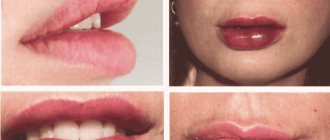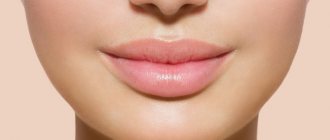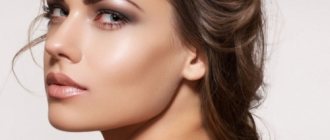Author
Chistyakova Olga Valentinovna
Leading doctor
Dermatologist
until January 31
Injections of youth: 15% discount on contouring, biorevitalization, wrinkle correction More details All promotions
Contour plastic
– this is the correction of the macrorelief of the skin (elimination of cosmetic defects) using special preparations – fillers. In modern cosmetology, contour plastic surgery is considered as an alternative to plastic surgery, allowing one to achieve an impressive effect non-surgically and with instant results.
What is contour plastic surgery? The essence of the method
Contour plastic
Fillers are injected intradermally (and in some cases subcutaneously) using injections. Fillers (from English to fill - “fill”) are gels that create volume at the injection site. The filler lifts the tissues above it, eliminating surface defects. As a result, wrinkles are smoothed out.
Currently, as a rule, biodegradable gels based on collagen or hyaluronic acid (a natural polymer originally present in skin tissue) are used. Preparations based on synthetic polymers are used only in certain cases (for example, to eliminate the consequences of injuries). Biodegradable gels are harmoniously integrated into the skin, and over time they are completely absorbed and removed from the body.
Granulomas after correction
Granulomas can appear on the skin as a result of the body’s protective reaction to an injected drug of poor quality. The body isolates the foreign substance and encloses it in capsules.
As you can see in the picture, red plaques and nodules appear on the skin at the injection site.
Laser exposure is used as a modern method of treating granulomas. There are also drug treatment regimens for granulomas. In any case, the treatment tactics are determined by the doctor during the consultation.
Advantages of facial contouring with hyaluronic acid preparations
- Injectable preparations based on hyaluronic acid increase the firmness and elasticity of the skin, even out its relief, eliminate wrinkles, strengthen the facial contour, and allow you to correct the shape of the cheekbones, chin and nose.
- Modern drugs, as a rule, do not cause an allergic reaction. The risk of complications when using them is minimal. They do not affect your facial expressions and facial expressions in any way, since they do not affect the work of facial muscles.
- Displacement of fillers based on hyaluronic acid is excluded, while synthetic preparations can migrate and thicken over time, causing deformation and provoking inflammation in the injection area.
What does a vessel embolism look like?
Vessel embolism is one of the most serious complications that occur in injected areas. As a rule, in the area of the nasolabial triangle and lips.
Vessel embolism results from:
- The filler has entered the lumen of the vessel (As a rule, a total blockage of the vessel occurs and the blood flow stops completely);
- The gel is injected in large quantities directly close to the vessel, this compresses it and makes it difficult for blood to pass through.
All this leads to the fact that the vessels are compressed, blood circulation is disrupted, and swelling of neighboring tissues increases.
It is difficult not to notice them: the injured area will be very painful, the area of the skin deprived of blood supply will turn white, and a clearly visible “mesh” of burgundy or blue color may appear around it - due to the overflow of blood in the surrounding vessels.
Visually, a vessel embolism looks like this:
- The blockage area turns white;
- Around the area, on the contrary, spots of a purple or bluish tint appear;
- Severe pain in the injured area.
All of the problems described above require urgent contact with your cosmetologist. If you try to treat it yourself, you may end up with tissue necrosis.
Areas of application of the contour plastic method
Fillers can be used on any areas of the skin that require correction. Facial contouring is especially in demand.
Contour plastic surgery: before and after photos
The following problems can be successfully solved with the help of contour plastic surgery:
- elimination of frontal wrinkles (wrinkles on the forehead) and wrinkles between the eyebrows;
- elimination of “crow’s feet” – wrinkles in the corners of the eyes;
- correction of nasolabial folds and cheekbones;
- correction of the corners of the mouth, elimination of wrinkles above the upper lip (perioral wrinkles);
- contouring and increasing lip volume;
- volumetric facial plastic surgery (cheekbones, chin).
Indications for the procedure
From a cosmetic point of view, contour plastic surgery with fillers is indicated for women and men over the age of 27 years.
To eliminate aesthetic defects, the procedure can be performed at an earlier age, since the drugs are completely biocompatible with the structures of the body.
The most common indications for the use of facial fillers are the following:
1. The desire to give facial features a more expressive, voluminous shape.
Plump and harmonious lips are the dream of many women. And hyaluronic acid in the form of injections can give the desired volume. The procedure is especially indicated when the upper lip is much thinner than the lower lip. Injections can also change the shape of the cheekbones, chin, and nose.
2. Wrinkles.
Nasolabial folds, nasolacrimal groove, crow's feet, longitudinal and transverse wrinkles on the forehead - all these signs of skin aging are a direct indication for contouring.
3. Fuzzy outline.
Sagging cheeks and chin (jowls) make the facial contour blurry, emphasizing aging skin and age. Injection harmonization can significantly transform the face, making the patient 10 years younger.
4. Asymmetry.
Injections with special dense preparations help balance facial features. In this case, it is especially important that the procedure is carried out by an experienced cosmetologist, so as not to get the opposite effect.
Fillers are used to solve aesthetic problems not only on the face, but also in other areas, even intimate (for example, to correct the shape of the labia).
Facial contouring with hyaluronic acid at “Family Doctor”
The cosmetologists at the “Family Doctor” are professionals of the highest class, masters of beauty, capable of providing truly high-quality results. Check out the benefits of facial contouring at Family Doctor clinics:
- The entire procedure takes on average 30-40 minutes. Of these, 20-30 minutes are occupied by anesthesia of the injection zone with an anesthetic cream, which includes one or more anesthetics (lidocaine, ultracaine, procaine).
- Microneedles are used for injections, leaving no traces.
- The effect of the procedure is noticeable immediately.
- After the procedure, slight bruising and swelling may appear, which will disappear in a few days, and then the effect will become even more obvious.
Summary
I will be honest with you: I do not consider this correction method a worthy alternative to plastic surgery. As practice shows, fillers do not give the result that the patient would like to see. And the use of budget synthetic fillers even leads to the need for surgical intervention in some cases.
A facelift with fillers is suitable for targeted corrections of subtle age-related changes. When you just notice the first strokes and want to hide them immediately.
Pronounced age-related changes require more serious procedures. Here I would recommend surgical methods of correction. Because the devices also do not always cope with complex tasks.
To summarize the above, I would add that each case is unique. Therefore, a specialist can advise you on a suitable correction method only after a personal conversation. To choose the best one for you, we need to look, evaluate and take a history. Do not forget about this and do not make a decision about a particular procedure without a personal conversation with a specialist.
Preparation
During a preliminary consultation with a cosmetologist, it is necessary to talk about previously performed contour plastic surgery and previously used drugs. It is important to provide the most complete and truthful information about your health status and medications taken.
The day before the procedure, you should not drink drinks containing alcohol, engage in active sports or exert yourself physically. If necessary, your doctor may recommend taking antiviral medications. For example, in the case of a tendency to herpetic rashes in the area of planned manipulations.
Types of injections for facelift
Injection rejuvenation is divided into seven categories:
- injections of drugs that block the function of certain facial muscles;
- injections of hyaluronic acid preparations;
- injections of collagen-containing preparations;
- introduction of meso-cocktails under the skin;
- autologous plasma rejuvenation procedure;
- volume replenishment with absorbable gels;
- introduction of mesothreads under the skin.
All methods of lifting the oval face have contraindications. If it is impossible to carry out injections, the doctor will recommend you a hardware or surgical method of lifting.
Many injections are performed using local anesthesia. After applying it, the doctor waits 15-20 minutes for the anesthesia to take effect. Procedures such as plasma lifting or collagen rejuvenation are usually done without anesthesia.
Contraindications
Like other injection procedures, contour plastic surgery is contraindicated:
- Pregnant and lactating;
- For bleeding disorders of any etiology (including within 2 weeks after taking anticoagulants);
- With a tendency to form hypertrophic/keloid scars;
- For any acute inflammatory diseases or exacerbation of chronic diseases;
- In case of an allergic reaction to the components of the drugs;
- Oncological diseases, without remission;
- Mental disorders;
- Excessive demands from the procedure, when expectations exceed the possibilities of correction;
- Persons under 18 years of age;
- Diabetes mellitus without compensation.
What does cosmetology offer for facial rejuvenation?
Now that you have understood the basics of dental pathologies that affect the appearance of the lower third of the face, let's look at the main range of cosmetic procedures that are aimed at maintaining facial tissue and skin in tone and which have an externally rejuvenating effect.
Let us immediately make a reservation that most of these procedures do not have a permanent effect, and in order to always look young (not only in the soul, but also in appearance), these rejuvenation procedures must be repeated regularly.
So, modern rejuvenation methods guard your beauty
Course of facelift procedures with injections:
- The effect of Botox lasts on average for six months, after this time you can make an appointment with a cosmetologist again;
- fillers stay under the skin for 3 to 12 months, then the injections need to be repeated;
- biorevitalization is done in a course of procedures at intervals of two to three weeks; a total of 3 to 8 sessions may be required;
- the number of mesotherapy sessions is prescribed individually; usually this is up to 8 visits to the clinic with a break of a week or 10 days;
- The collagen-containing preparation is re-injected under the skin three times with an interval of two weeks;
- Plasmolifting is done according to the following scheme: 3 times in six months.
Courses are repeated over time. Your doctor will advise you in detail about the duration of the injection effect.
External changes in the lower third of the face
Asymmetry - how to correct the situation?
Most radical and “global” rejuvenation treatments affect the lower third of the face. Why? The answer is quite simple: it is in the lower third of the face that the dentofacial system is concentrated, which, for a number of reasons, undergoes significant changes, leading to changes in the surrounding facial tissues. The process, if described in simple words, looks like this: the bone atrophies, the tissue follows the bone. Visually, this violates the aesthetics of the face, causing facial asymmetry.
The presence of bite pathologies can also affect facial aesthetics
.
Let's look at it in order:
First, as it happens, one tooth is lost
.
Missing one tooth. Starting factor #1
If only one tooth is missing, then at first it may not be very noticeable; the contour of the lips will change slightly, as the lip will begin to “sink” into the place of the missing tooth.
But there is one important point: the bone tissue in the absence of a tooth will begin to dissolve.
What does this mean from the point of view of violation of facial aesthetics:
- The necks of neighboring teeth will gradually begin to become exposed and their loss may occur,
- in this case, the lip will sink even more, affecting the neighboring muscles, and small vertical folds may appear above the lip.
The loss of one tooth is not critical, but you need to know that as a result of the loss of a tooth in the chewing region, the load will begin to be redistributed to other teeth, including the anterior frontal region. And the additional, unplanned by Nature, load on the teeth leads to their abrasion
. When two or more teeth are lost, the processes of distributing the load on adjacent teeth begin to occur more actively.
So, the next factor is tooth wear.
Tooth wear and bruxism. System factor #2
Now let's look at what happens with tooth wear and bruxism.
At its core, tooth wear involves abrasion of the tooth tissue. With pathological abrasion and bruxism, this process occurs many times faster, the crown part of the tooth decreases, and again the height of the lower third of the face decreases.
When teeth wear down, changes occur in the temporomandibular joint, just as in the absence of teeth.
What aesthetic defects
faces appear when erased:
- the lower jaw gradually begins to rise upward,
- the distance between the tip of the nose and the chin decreases,
- nasolabial folds increase,
- Vertical wrinkles appear around the lips.
The next factor in external aesthetic changes in the face is malocclusion
. This is one of the most common problems.
Malocclusion. Global factor #3
If the teeth are not positioned visually, it may:
- the tip of the chin moves,
- a second fold appears under the chin,
- “cluttered” chewing teeth can externally “round” the jaw line at their location, that is, the jaw line from the chin towards the ear will not be “chiseled”.
- also, if the teeth are incorrectly positioned, the lower jaw can protrude forward or, on the contrary, move backward - outwardly such a chin looks “sloping”, as if the neck immediately begins from the chin.
Bite pathology very often “adds” a sufficient number of unplanned wrinkles
.
From an aesthetics point of view, a problem arises that very often begins to be solved with the help of cosmetic procedures: Let’s look at what it looks like using specific examples of only two malocclusion pathologies (and there are many more of them).
Did you know that, for example, the feature of the distal occlusion
is there an imbalance in jaw development?
The teeth of the upper jaw quickly begin to protrude above the lower ones, while the lower jaw lags behind in development, as a result of which the chin appears small and looks unnatural. From an aesthetic point of view, this leads to the appearance of wrinkles
in the lip area. And the face itself becomes unattractive.
And in case of deep bite
there is a significant overlap of the lower dentition with the upper teeth and, as a consequence of such contact, there is increased wear of the teeth, which we talked about earlier in factor #2, which further leads to a reduction in the lower third of the face.
We started the story with factor #1 - the loss of one tooth. But the most serious problems of facial aesthetics begin with the loss of several teeth, when bone tissue atrophy begins to develop, entailing, in fact, both bone atrophy and changes in the structure of soft tissues.
So - edentia. Global factor #4
Adentia can be either complete or partial. With complete edentia, there is a complete absence of teeth on one or both jaws. Partial edentia implies the absence of one or two teeth or a segment of teeth, for example chewing teeth. Loss of teeth, especially complete loss, immediately affects the appearance of the face.
If teeth are missing, the height of the lower third of the face decreases, what does this lead to? This leads to a loss of support for the jaws by the teeth, as a result of which the jaw moves backward in the joint area, and forward and upward in the chin area. This is how an “old man’s face” appears - the distance between the tip of the nose and the top of the chin decreases.
How does edentia appear on the face?
What aesthetic defects appear on the face during the development of edentia:
- all folds naturally begin to deepen, nasolabial folds become pronounced - they descend to the corners of the lips,
- the lips outwardly look much thinner, since when they lose support from the teeth, they shift towards the oral cavity,
- the tone of facial muscles decreases, the cheeks and chin tissues sag,
- in the absence of a group of chewing teeth, the soft tissues begin to “fall” inward.
- and with a long-term absence of chewing teeth, bone tissue begins to dissolve, outwardly it looks like very “sunken cheeks.”
As you can see, all these factors influence changes in the appearance of the face, its shape and gives asymmetry. Changes can occur regardless of age, but at the same time they make the face look older due to the deepening of the nasolabial folds and incorrect position of the jaws.
First stage: correction of the angle of the lower jaw
The angle of the mandible is formed by the connection of the posterior border of the ramus and the lower edge of the body of the jaw. X-ray studies have shown that the average mandibular angle in women is 125 degrees, but this value varies even in aesthetically attractive patients.
The main goal when correcting the lower part of the face is to emphasize and make the patient’s natural mandibular angle more pronounced.
Technique
1. Determine volume loss in the preauricular space.
2. By palpation, find and mark the angle of the lower jaw.
3. Using a 23-gauge needle, create an entry point located superomedial (often at a distance of 0.5 cm) in relation to the mandibular angle.
4. Mark the future lower border and the posterior part of the body of the lower jaw (Fig. 1).
5. Use a 25-gauge (4 cm) cannula to aspirate to avoid intravascular injection of filler.
6. Using the linear-retrograde technique, inject filler (0.1 ml per line) in a volume of 0.5–1 ml in each direction.
7. Shape the product to achieve the ideal angular contour by gently palpating between the tips of two fingers.
Potential Risks
During correction of the posterior ramus of the mandible, the facial nerve and parotid gland are at risk because these two structures are located deep. You can avoid affecting them by injecting filler into the subdermal plane. When introducing the product into the lower edge of the maxillary branch, it must be remembered that the facial artery runs along the anterior edge of the masticatory muscle. It must first be palpated and excluded from the injection area.
Brief description: Purpose: to make the mandibular angle clearer.
Depth of injection: superficial/subdermal.
Volume: 0.5–1 ml per side.
Technique: cannula. Products of choice: Restylane Defyne, Restylane Volyme or Restylane Lyft
Second stage: contouring of the chin area (H3)
To determine the ideal proportions of the face, it is usually divided into three equal horizontal thirds and five vertical sectors (Fig. 2). Ideally, the chin occupies the central vertical sector.
Injections for facial skin tightening: price in Moscow
| Method | Price |
| Botox/Dysport | 380 / 95 rub. for 1 unit |
| Fillers | from 10,000 rub. |
| Biorevitalization | from 10,000 rub. |
| Mesotherapy | from 4550 rub. |
| Collagen rejuvenation | from 5000 rub. |
| Plasmolifting (method of R. Akhmerov) | from 6,000 rub. |
| Plasmolifting RegenLab (Switzerland) | from 15,500 rub. |
The introduction of drugs under the skin can be combined with laser and hardware procedures, as well as plastic surgery. Many patients practice an integrated approach to preserving beauty, and we regularly reduce the cost of facial contour lifting methods as part of seasonal promotions. All so you can afford more!
In our clinic, all specialists are proficient in injection cosmetology methods. Each doctor is certified in injection lifting training. Your beauty is our profile.
You can sign up for consultations by calling
+7
or using the feedback form below.











